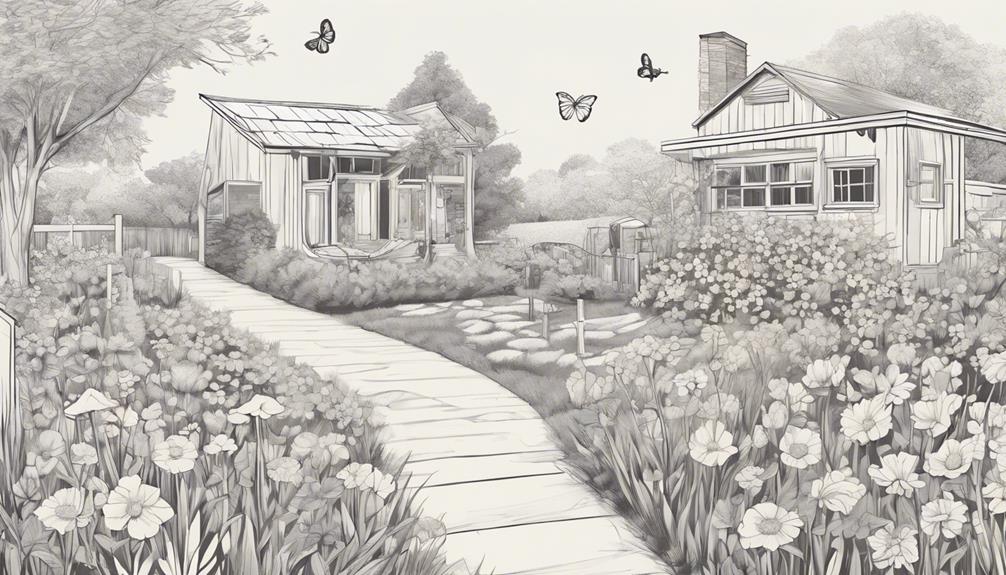How To Become More Self-Sufficient Without Starting a Full-Blown Farm…
Want to start preserving your harvest, making your own soap, or building a backyard root cellar — but not sure where to begin? “Homesteading Advice” gives you instant lifetime access to 35+ practical homesteading books on food preservation, veggie gardening, DIY natural cleaning products (save over $250 per year with this skill alone), brewing, off-grid energy, and a whole lot more…
Click Here To Check It Out Now!
“I’ve started a backyard farm in Boulder, Colorado, and I’m eager to promote pollination for my vegetables and fruits. How do I include pollinator habitats in my layout?” Thanks, Jessica, Boulder, USA.
Understanding Pollinators and Their Importance
Pollinators like bees, butterflies, and hummingbirds play a crucial role in the ecosystem. They help plants reproduce by transferring pollen from one flower to another, leading to fruit and seed production. Without them, your backyard farm wouldn’t thrive as it should. Ensuring their habitat is part of your layout can significantly enhance pollination, thus boosting your farm’s yield.
Planning Your Backyard Layout
Considerations for Habitat Spaces
Jessica, let’s consider how to allocate space for pollinators in your backyard farm:
- Size and Diversity: Your habitat doesn’t need to be large. Even a small patch can attract pollinators if filled with the right plants.
- Location: Choose sunny spots since most pollinators love sunlight.
- Shelter: Including woody areas or shrubs can provide hiding spots from predators and extreme weather.
Choosing the Right Plants
Diversity is key here. Different pollinators are attracted to different plants. Consider including the following:
- Native Plants: They’re well-suited to the local environment and are usually more attractive to local pollinators.
- Flowers: Choose flowers of different shapes and colors. Bees prefer blue, purple, and yellow flowers, while butterflies love bright, flat-topped flowers.
- Bloom Times: Ensure continuous bloom throughout the growing season. This means planting early, mid, and late-season bloomers.
Creating a Pollinator-Friendly Environment
Provide Food Sources
Pollinators need nectar and pollen. Some extensive choices are:
- Lavender: Attracts bees and butterflies with its vibrant color and scent.
- Sunflowers: Loved by bees and provide seeds for birds.
- Milkweed: Essential for monarch butterflies.
Ensure a variety of plants to provide continuous food supply.
Water Sources
Pollinators need water too. Small, shallow water sources with stones for perching will do the trick. Try:
- Birdbaths: A simple and effective water source.
- Shallow Dishes: Fill with water and add pebbles so pollinators can drink without drowning.
Avoiding Harmful Chemicals
Protect pollinators by minimizing or eliminating pesticide use. Organic alternatives and natural pest control methods are safer options. For example:
- Neem Oil: Effective against many pests and safe for pollinators when used correctly.
- Companion Planting: Planting pest-repelling plants like marigolds can reduce the need for chemical control.
Designing Specific Habitats
Bees
Bees are perhaps the most renowned pollinators. Creating a habitat for them is straightforward:
- Bee Houses: Construct or buy houses to provide nesting spots for solitary bees.
- Bare Ground: Some bees nest in the ground. Leave a patch of untreated soil.
- Diverse Flowers: Plant a mix of flowers as detailed earlier.
Remember, Jessica, bees are not aggressive when undisturbed. They’re nature’s hardworking pollinators.
Butterflies
Butterflies add beauty and vital pollination to your backyard farm. Here’s what they need:
- Nectar Plants: Examples include coneflowers, zinnias, and lantana.
- Host Plants: Caterpillars need specific plants, like milkweed for monarchs.
- Sunning Rocks: Flat rocks in sunny areas for warmth absorption.
Integrating Pollinator Zones
Creating Zones
Jessica, organizing your farm into zones helps each section thrive without competing for resources. Consider these zones:
- Pollinator Zone: A dedicated area just for pollinator plants.
- Vegetable Zone: Surround this with pollinator plants to attract pollinators right where they’re needed.
- Herb Zone: Many herbs flower and attract pollinators, providing added benefit.
Edge Planting
Plant pollinator-attractive species along the edges of garden beds. This not only beautifies the space but also makes it easier for pollinators to find flowers. Some edge planting options include:
- Nasturtiums: Attracts bees and beneficial insects.
- Alyssum: Extremely attractive to various pollinators.
Monitoring and Maintenance
Regular Monitoring
Keep an eye on what kinds of pollinators frequent your farm. You might notice trends and will be able to adjust plantings accordingly. Consider creating a simple log to record observations.
Ongoing Care
Maintenance is key to a healthy pollinator garden:
- Pruning: Regularly prune to encourage growth and blooming.
- Weeding: Minimize competition by keeping weeds in check.
- Soil Health: Use compost and organic matter to keep soil fertile and healthy.
Educational Opportunities
Creating a pollinator habitat provides a great educational opportunity for kids and visitors. Consider these ideas:
- Informational Signage: Small signs identifying plants and explaining their ecological roles can be very educational.
- Workshops and Tours: Invite local schools or gardening clubs for tours to share knowledge and enthusiasm for pollinator conservation.
Benefits of Pollinator Habitats
These habitats bring numerous benefits beyond aiding your plants, including:
- Enhanced Biodiversity: A more diverse range of species can flourish.
- Improved Plant Health: Better pollination leads to stronger, more resilient plants.
- Aesthetic Appeal: Colorful blooms and fluttering butterflies make your garden visually stunning.
Tips for Long-Term Success
Achieving a thriving pollinator-friendly backyard farm is a marathon, not a sprint. Here are some parting tips:
- Keep Learning: Stay informed about local plant species and newer techniques in sustainable gardening.
- Community Engagement: Engage with local gardening groups or online forums to exchange ideas and experiences.
- Be Patient: Habitats take time to develop. The rewards will come with each blooming season.
Final Thoughts…
Thank you, Jessica, for your insightful question. Incorporating pollinator habitats into your backyard farm layout promotes a harmonious environment where plants and pollinators support each other. You’ll not only see better yields from your garden but also contribute to the larger environmental health.
Happy gardening and good luck with your backyard farm, Jessica!

